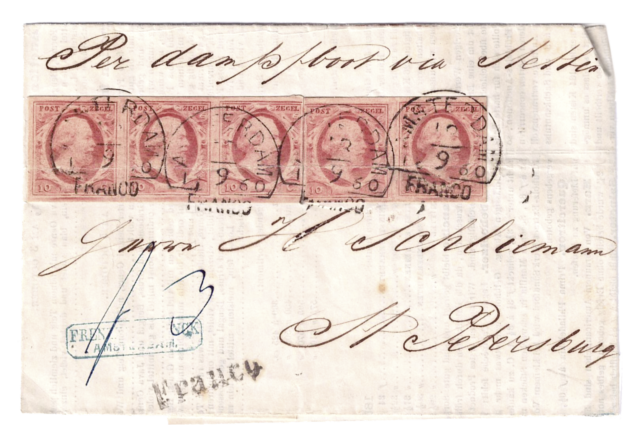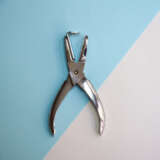A huge passion for 2 x 2 cm
It is a science in and of itself: as a philatelist, or stamp collector, Udo Zimmermann (QM Homberg) devotes a great deal of time to these valuable pieces of paper. His specialty: the first three stamps issued by the Netherlands. They were printed between 1852 and 1863, and he possesses a wide range of variations of these three stamps.

Letter to the discoverer of Troy Heinrich Schliemann
To be honest, the term “collect” does not do justice to Zimmermann’s hobby. He documents his finds with loving attention to detail. Where did the letter travel, and to whom was it addressed? He is able to tell, from fine streaks or other indications, not only the printing plate used to print the stamp, but also its location in the sheet of stamps. Zimmermann: “It takes me between five and ten minutes to do that, depending how worn the plate was.” It’s quite possible that he is the only person in Germany with this sort of knowledge.
Zimmermann’s collection boasts around 100 letters and over 1,000 individual stamps. And some of these are associated with fascinating stories: patents, dunning notices, even an offer for English coal. One particularly unusual example involves a letter that was addressed to Heinrich Schliemann. Schliemann, a merchant and archaeologist, is considered to be the discoverer of the legendary city of Troy in modern-day Turkey. During his excavations, he also found the Treasure of Priam, which is sometimes referred to as the Trojan Gold.

Udo Zimmermann and his stamp collection
“Like an audit at KAMAX”
Udo Zimmermann regularly displays his collection at events. In 2023, his schedule includes the German championships in Trier and an international competition in Koper, Slovenia. Philatelists from around the world get together here. Judges assess the exhibits according to a variety of criteria: How well is the collection documented? Is the historical background properly explained? As a smiling Zimmermann put it: “It’s a bit like an external system audit at KAMAX.” Jurors assign up to 100 points in various categories, with the highest honor being a “Grand Gold.” Zimmermann’s biggest success to date: participation in the 2022 world championships in Budapest with more than 300 other collectors.
And, as if Zimmermann didn’t already have enough to do, he is also involved in a second “collection.” This one’s called “Kinder helfen Kindern” (children helping children). There is a tradition in the Netherlands that schoolchildren go from house to house selling charity stamps every November to collect donations. Every year, more than 100,000 schoolchildren take part, with teachers taking charge of coordination in the schools. The proceeds are given to disadvantaged children. This campaign has been around since 1948, and it has been recognized as an intangible cultural heritage. Zimmermann: “I collect stamps, as well as thank-you cards for teachers or major customers.”
Stamps instead of football
His focus on the Netherlands arose purely by chance: Around 40 years ago, while in the Netherlands with his football team, he had a minor car accident. The Dutch teammate who helped him out happened to work at the post office, and he is the one who got him interested in historical stamps. While the philatelist eventually gave up playing football, he has continued compiling an impressive amount of expertise in the field of stamps. Today he is active in a variety of associations and writes articles for trade publications. Zimmermann also finds new treasures at trade shows and swap meets in the Netherlands, as well as at auction houses and online exchanges. There’s one thing he still has not been able to get, however: “There is a trial plate for the ten-cent stamp. Some 200 stamps were accidentally released into circulation, and I have not been able to obtain any of them. Not yet.”

Three stamps – 1,700 variants
Although there are officially only three “first stamps” in the Netherlands, Udo Zimmermann distinguishes between 1,700 such stamps. Why? The demand for stamps was so great that they quickly had to begin producing more. And, because they used different paper, and sometimes different inks, new variants were created. Finally, when the printing plates became worn, the variety grew even greater with the new plates. There were six different plates used for the five-cent stamp, and ten plates for the ten-cent stamp.
KXpress










